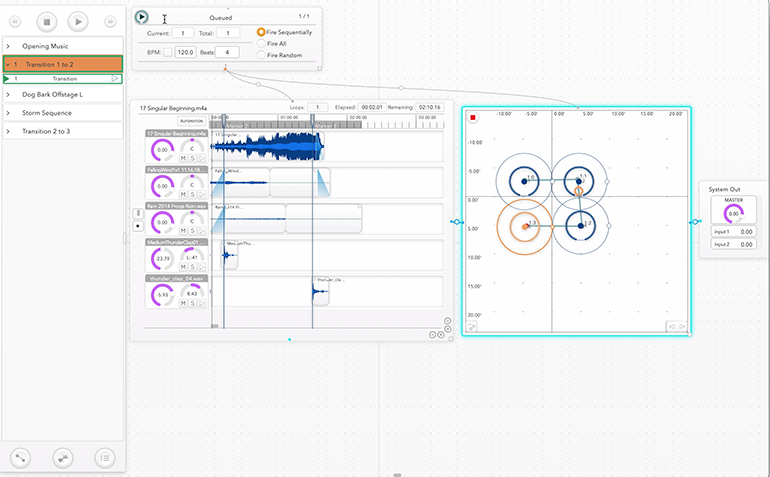Canvas, a new software program from Avae, aims to lower the technical barriers to creativity in sound design for live performance. The system is based on a simple, non-linear user interface that lets you connect sound effects, music, and other building blocks of your show; early versions of Canvas have been used at the Kennedy Center, the Prague Quadrennial, Shakespeare Theater, and Woolly Mammoth. Canvas Version 1.0 launched in August; the software is offered by subscription and is available for free to students and early-stage designers.
I sat down with Avae CEO Chris Baine to learn how Canvas came to be and how his company wants to empower sound designers.
Sarah Jones: You’re a sound designer and composer. What was lacking in available tools that led you to create your own software?
Chris Baine: There were a lot of things I felt were lacking in today’s tools that led me to create Canvas. But the most important one to me as a designer was the ability to create dynamic, flexible sound designs. The power of a live performance is that it varies from show to show. With each performance, actors’ intonations, movements, and timings are varied, and designers must be able to respond to the action onstage to communicate realistic, engaging scenes.
Currently, the technology available to us locks us into a very static environment where everything runs exactly the same as before. If you’d like to introduce more flexibility, more interactiveness, more detail, you really have to go out of your way to achieve that. One of the areas I felt was lacking was this ability to provide a more interactive, flexible design that fits seamlessly into the production, which a designer can create easily and quickly.
SJ: How scalable is the Canvas platform?
CB: Canvas is very scalable and is limited mostly by your computer specs. You can run a simple show to a very complex show on it. For instance, I used Canvas recently to build and run a complex show at the Kennedy Center that contained hundreds of cues. We are constantly optimizing it and working with designers to understand what they need and how Canvas can support them.
SJ: Sound production is a balance of art and technology; as tools get more complex, there’s always a danger of adapting to the confines of our user interfaces. How does Canvas let sound designers reach their creative potential?
CB: This is something I am very passionate about. Like it or not, art is limited by the tools available to the artist. The tools you have at your disposal influence what you create, and influence that process of creation.
We are attempting to create an open tool that gives artists an intuitive palette to paint with. Rather than limiting artists to a rigid, static list of cues, we provide a non-linear interface to help them visualize what’s happening in their design. You can easily drag and drop the elements of your design onto a blank canvas, connecting and controlling them however you’d like. We want to foster creativity by removing the limitations of technology and making it simpler to build a show.
There are a ton of examples where the technology becomes easy enough and cheap enough that it lowers the barrier of entry into a field. We want this to happen with sound design. What should get people work in the field isn’t their technological knowledge, but their talent and their art. Canvas seeks to help lower this barrier of entry by making it simpler to do historically complicated tasks.

SJ: Can you hint at any long-term tech goals for the Canvas platform?
CB: Canvas is built for sound designers, and we’re constantly getting feedback to make the software the best it can be. We want to handle the technology so designers can focus on creating. So, one of our long-term goals is to create a software that allows artists to be able to work with us directly, so we can create something together to help achieve their ideas.
For example, we are currently working on a few requests from designers. One focuses on composers even more, to give them more tools for making interactive music. Another we are working on is an element that may make working with other design fields easier.
We are also thinking a lot about the current trend toward non-standard productions, like multi-room environments, choose-your-own-adventure shows, non-linear storytelling, etc. So, one of our goals is to give artists who do non-standard work better tools to accomplish these types of shows. We are looking a lot at the gaming industry and the tools they use, to adapt Canvas to these kinds of productions. This involves how we think about cueing, how we think about our environment, and how a sound design can seamlessly follow a person through a space to create a more dynamic experience.
Sarah Jones is a writer, editor, and content producer with more than 20 years' experience in pro audio, including as editor-in-chief of three leading audio magazines: Mix, EQ, and Electronic Musician. She is a lifelong musician and committed to arts advocacy and learning, including acting as education chair of the San Francisco chapter of the Recording Academy, where she helps develop event programming that cultivates the careers of Bay Area music makers.